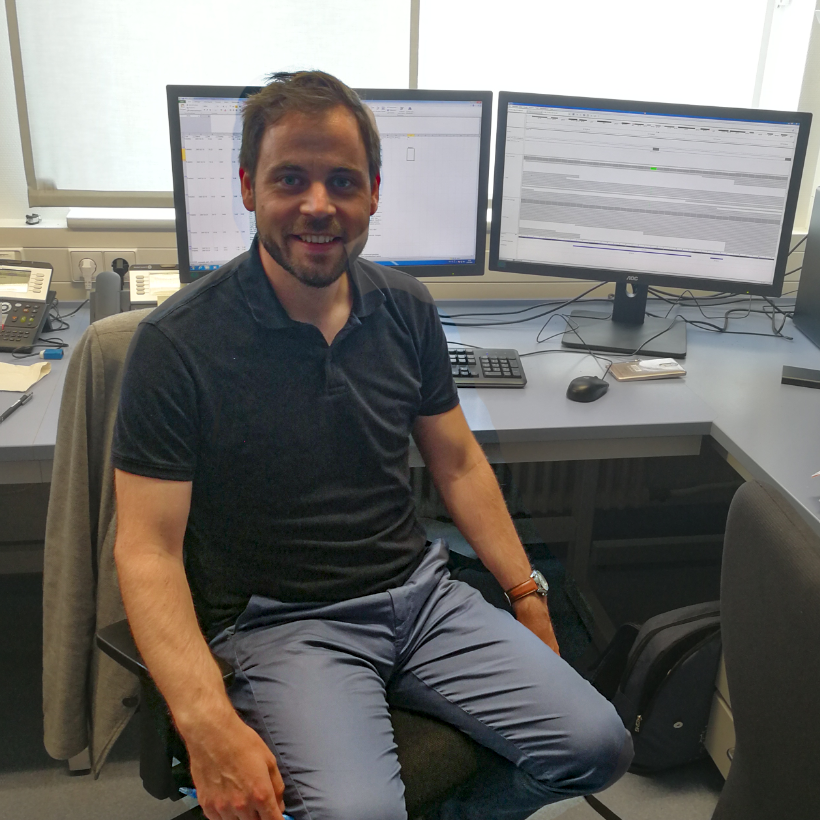Viktor Molnár is from the Institute for Medical
Genomics and Rare Diseases of Semmelweis University
of Budapest and came to learn the advanced tricks of
NGS data analysis and interpretation. The six weeks
of his stay in the beautiful city of Tübingen during the
summer 2018 were supported by the ERN-RND fellow-
ship program.
- What was your motivation for participating in
this Fellowship Programme?
This program ensures the opportunity for young
healthcare professionals involved in the care of
rare neurological disorders to gain insight into
the operation of an experienced centre.
In the institute (Institut für Medizinische Genetik und Angewandte Genomik Tübingen, headed by Prof. Olaf Riess), I got a lot of help in the analysis of our data derived from whole exome sequencing of Hungarian patients with interesting neurological phenotypes.
- How long did you stay in the Institute for Medical Genetics and Applied Genomics in Tübingen?
It was planned to stay there for 6 weeks which was enough to complete the reanalysis of our data. I had enough time to become familiar with the whole diagnostic and research pipeline or to take part in training lectures as well.
- With whom did you work?
The colleagues were very helpful. On the first day, the group leader Dr. Tobias Haack introduced me to the institute and colleagues. I worked together with the analysis specialist medical doctors, biologists and bioinformaticians most of the time. I would like to thank Dr. Rebecca Buchert and Dr. Marc Sturm for guiding and supporting in the interpretation of findings. It is also impressive to see how they organize the day, how the data management and sharing works, how much time they spend with the analysis (go-no go decisions) and how to approach the solution in the really interesting cases. It is apparent at first sight how tirelessly enthusiastic they do this work.
- What did you work on?
The main goal was to complete the reanalysis of our WES data with the help of the here developed and routinely applied pipeline. It can be further complemented with detection of CNVs, homozygous regions and further various approaches as well. The most important advantage is derived from access to a large dataset that enables to detect and exclude the population specific variants. The software, the in-house annotations and preassembled gene lists with disease causing can also aid a lot in variant interpretation.
- What did you learn?
I learned that it is very important to gain insight into the practical details that you cannot find in guidelines and articles. Even in labyrinth of interpretation there are many similarities and differences, of course. Facing similarities means that in these points we are on the right way that gives us more self-confidence. In case of differences, they should be considered, whether they are applicable or highlight the possible issues in where we could develop.
- As a healthcare professional, how do you benefit from the ERN-RND?
Well, I am sure that I will return to my home institute (Institute for Medical Genomics and Rare Diseases of Semmelweis University of Budapest, headed by Prof. Judit Mária Molnár) with a lot of experience.
In my opinion a similar knowledge transfer and experience sharing can facilitate the development very effectively. I think the future for rare diseases, as well as neurological ones is based on cooperative work. The role of physician will become even more valuable not only in providing high-quality phenotypic data but also in support of interpretation of candidate variants. For a clinician who is working with patients with rare neurological disorders, it is essential to understand the whole diagnostic workflow and decision points from the indication till the overview of possible treatment options. This field, the clinical utilization of genomic data contributes probably to the greatest extent to revolution of neurogenetics. At the same time it marks the way certainly to which the research and the whole translation chain could be anchored.
In the new era of clinical genomics, I think the regulated access to available data, genotype (or more, e.g. transcriptom, proteom) and phenotype (from histology till the longitudinally evolution of symptoms) will be essential. International associations and initiatives, like ERN-RND and cross-border knowledge transfer will play a central role.

